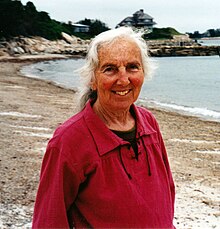Ruth Hubbard
| Ruth Hubbard | |
|---|---|

Ruth Hubbard Wald, on the beach in Woods Hole, MA
|
|
| Born | Ruth Hoffmann March 3, 1924 Vienna, Austria |
| Died | September 1, 2016 (aged 92) Cambridge, Massachusetts, U.S. |
| Institutions | Harvard University |
| Alma mater | Radcliffe College |
| Spouse |
Frank Hubbard (m. 1942–51) George Wald (m. 1958–97) |
| Children |
Elijah Wald Deborah Hannah Wald |
Ruth Hubbard (March 3, 1924 – September 1, 2016) was a professor of biology at Harvard University, where she was the first woman to hold a tenured professorship position in biology.
During her active research career from the 1940s to the 1960s, she made important contributions to the understanding of the biochemistry and of vision in vertebrates and invertebrates. In 1967, she and Wald shared the Paul Karrer Medal for their work in this area.
In 1924, Hubbard was born Ruth Hoffmann in Vienna, Austria and escaped Nazism as a teenager. With her family, she moved to the Boston area and she became a biologist. She graduated from Radcliffe College in 1944, earning an A.B. in biochemical sciences.
As a research fellow at Harvard in the years after World War II, she worked under George Wald, investigating the biochemistry of retinal and retinol. Wald shared the Nobel Prize in Physiology or Medicine in 1967 for his discoveries about how the eye works. She received a Ph.D. in biology from Radcliffe in 1950, and in 1952, a Guggenheim fellowship at the Carlsberg Laboratory in Copenhagen, Denmark.
Hubbard made many important contributions to the visual sciences but her single most important was the fact that visual excitation is initiated by a chemical rearrangement of the visual pigment (rhodopsin) which is called a cis-trans isomerization. She showed that this is the only direct action of light on the visual system. She also identified the specific intermediate in the visual cycle (called metarhodopsin2) that leads to downstream effects, that culminate in a light-activated neural signaling to the brain Hubbard also described the bleaching and resynthesis of the rhodopsin molecule each time a photon is absorbed. She also discovered retinene isomerase (now called RPE65) that converts all-trans retinal (the post-illumination form) back into 11-cis retinal. She also studied the visual pigments in several new species. Her early work focused on the basic properties of rhodopsin, which is a combination of the chromophore (retinal) and a protein called opsin, which is reutilized in the resynthesis of rhodopsin. Hubbard published at least 31 scientific papers devoted to vision. Like her husband, she remained scientifically active until about 1975, and she made an excellent scientific presentation of her husband's work at a symposium in his honor. George Wald was 18 years older than Hubbard and he died in 1996.
...
Wikipedia
